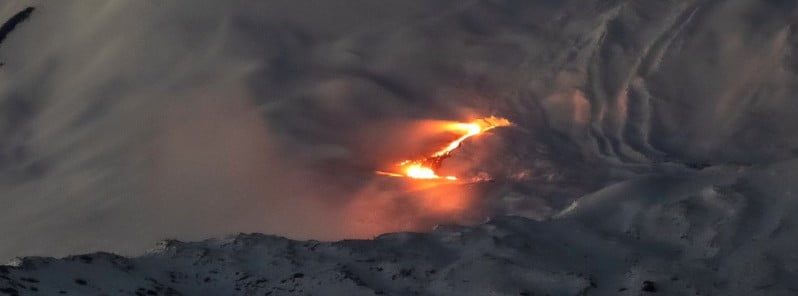New eruptive fissure vent opens at Etna, Italy

A new eruptive fissure event opened at the northeastern base of Etna’s SE crater on November 27, 2022. The vent was first seen at around 17:00 UTC when persistent cloud coverage thinned.
The vent is located at an altitude of 2 800 m (9 200 feet) above sea level.
A small lava flow is slowly moving toward the Valle del Leone.1
The Aviation Color Code was raised from Green to Yellow at 18:48 UTC and to Orange at 21:44 UTC when Etna Volcano Observatory reported lava flow at summit craters.
There were no ash clouds reported.
Etna showed signs of increased unrest on November 15, 2022, forcing the Etna Volcano Observatory to raise the Aviation Color Code for the volcano from Green to Yellow. It was lowered back to Green at 10:20 UTC on November 16 after geophysical parameters returned to background levels.2
Geological summary
Mount Etna, towering above Catania, Sicily’s second-largest city, has one of the world’s longest documented records of historical volcanism, dating back to 1500 BCE.
Historical lava flows of basaltic composition cover much of the surface of this massive volcano, whose edifice is the highest and most voluminous in Italy.
The Mongibello stratovolcano, truncated by several small calderas, was constructed during the late Pleistocene and Holocene over an older shield volcano. The most prominent morphological feature of Etna is the Valle del Bove, a 5 x 10 km (5.1 x 6.2 miles) horseshoe-shaped caldera open to the east.
Two styles of eruptive activity typically occur at Etna. Persistent explosive eruptions, sometimes with minor lava emissions, take place from one or more of the three prominent summit craters, the Central Crater, NE Crater, and SE Crater (the latter formed in 1978).
Flank vents, typically with higher effusion rates, are less frequently active and originate from fissures that open progressively downward from near the summit (usually accompanied by strombolian eruptions at the upper end).
Cinder cones are commonly constructed over the vents of lower-flank lava flows. Lava flows extend to the foot of the volcano on all sides and have reached the sea over a broad area on the SE flank.3
References:
1 COMUNICATO ETNA – INGV – November 27, 2022
2 Etna showing signs of renewed unrest, Italy – The Watchers – November 16, 2022
3 Etna – Geological summary – GVP
Featured image credit: Etna Walk

Commenting rules and guidelines
We value the thoughts and opinions of our readers and welcome healthy discussions on our website. In order to maintain a respectful and positive community, we ask that all commenters follow these rules.